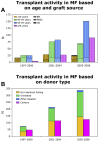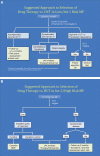Allogeneic hematopoietic cell transplantation for myelofibrosis in the era of JAK inhibitors
- PMID: 22700718
- PMCID: PMC5800543
- DOI: 10.1182/blood-2012-05-399048
Allogeneic hematopoietic cell transplantation for myelofibrosis in the era of JAK inhibitors
Abstract
The discovery of JAK2617F mutation paved the way for the development of small molecule inhibitors of JAK1/2 resulting in first approved JAK1/2 inhibitor, ruxolitinib, for the treatment of patients with myelofibrosis (MF). Although JAK1/2 inhibitor therapy is effective in decreasing the burden of symptoms associated with splenomegaly and MF-related constitutional symptoms, it is neither curative nor effective in reducing the risk of leukemic transformation. Presently, allogeneic hematopoietic cell transplantation (HCT) is the only curative therapy for MF. A significant risk of regimen-related toxicities, graft failure, and GVHD are major barriers to the success of HCT in MF. Because of significant HCT-associated morbidity and mortality, divergent opinions regarding its appropriate role in this clinical situation have emerged. In this review, the risk-benefit ratios of modern drug therapy compared with HCT in MF patients are analyzed. A risk-adapted approach individualized to each patient's biologic characteristics and comorbidities is described, which is currently warranted in determining optimal treatment strategies for patients with MF. Inclusion of JAK1/2 inhibitor therapy in future transplant conditioning regimens may provide an opportunity to overcome some of these barriers, resulting in greater success with HCT for MF patients.
Figures



References
-
- Tefferi A. Myelofibrosis with myeloid metaplasia. N Engl J Med. 2000;342(17):1255–1265. - PubMed
-
- Mesa RA, Silverstein MN, Jacobsen SJ, et al. Population-based incidence and survival figures in essential thrombocythemia and agnogenic myeloid metaplasia: an Olmsted County Study, 1976-1995. Am J Hematol. 1999;61(1):10–15. - PubMed
-
- Cervantes F, Dupriez B, Pereira A, et al. New prognostic scoring system for primary myelofibrosis based on a study of the International Working Group for Myelofibrosis Research and Treatment. Blood. 2009;113(13):2895–2901. - PubMed
-
- Gangat N, Caramazza D, Vaidya R, et al. DIPSS plus: a refined Dynamic International Prognostic Scoring System for primary myelofibrosis that incorporates prognostic information from karyotype, platelet count, and transfusion status. J Clin Oncol. 2011;29(4):392–397. - PubMed
Publication types
MeSH terms
Substances
Grants and funding
LinkOut - more resources
Full Text Sources
Other Literature Sources
Research Materials
Miscellaneous

